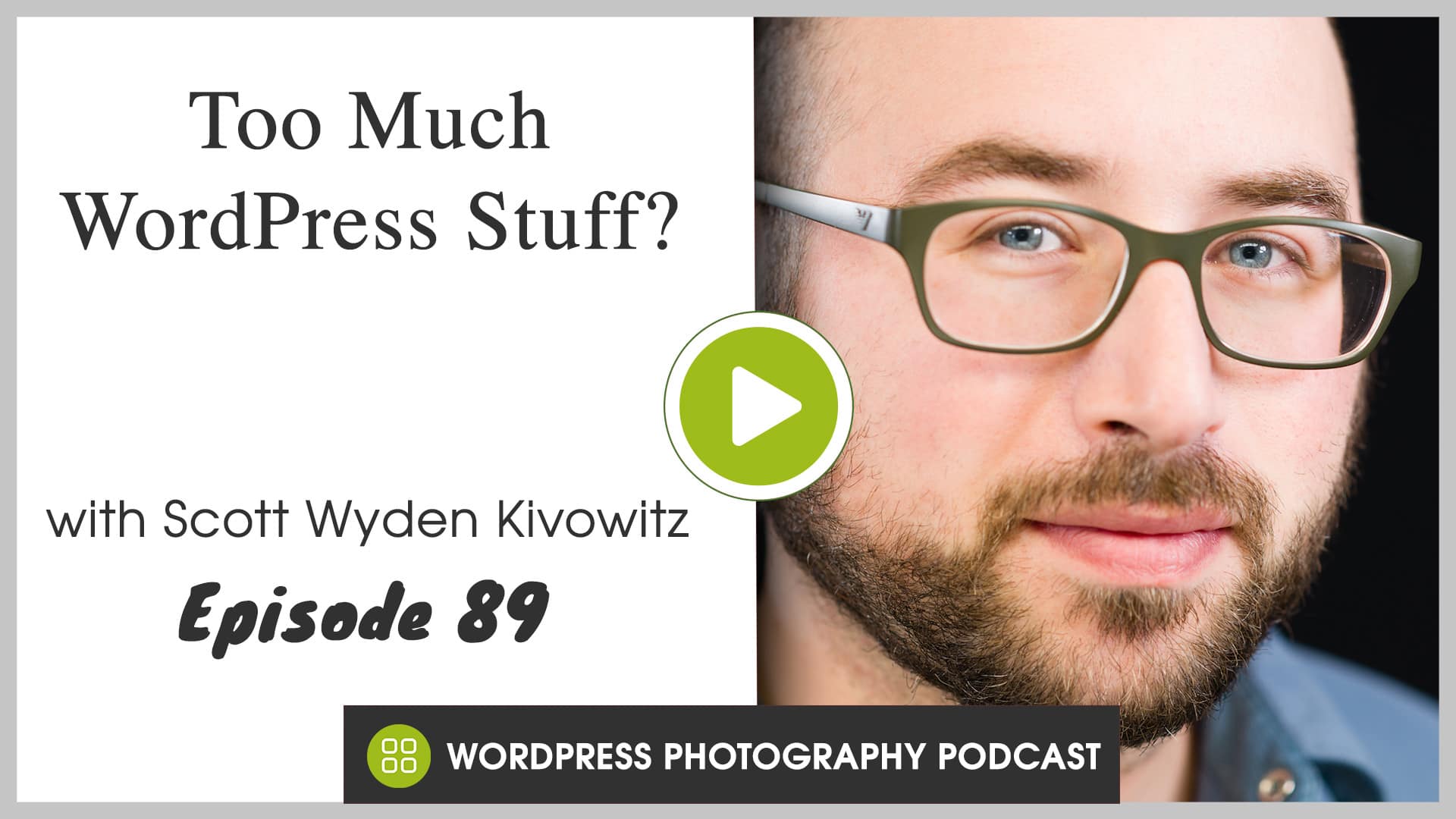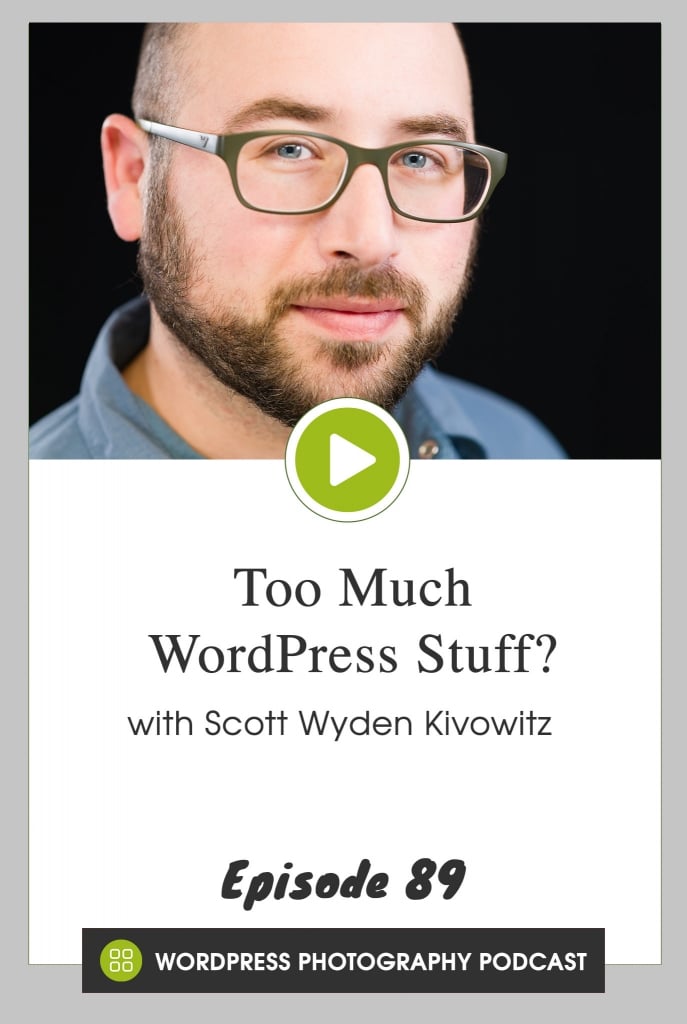
/
In today's episode, we are going to start a conversation about adding plugins to your site. We will discuss security, backups, server strain, and even a term that gets thrown around a ton, bloat.
Joke of the day:
We all have a photographic memory. Just some of us are lacking the film.
Something just came up in a Facebook group, and I realized I should have recorded a podcast episode about it long ago. So that's what I am doing right now. The topic is, "adding too much stuff to WordPress."
- Is it good?
- Is it bad?
- What are the risks?
- Why do it?
So in today's episode, I'm going to discuss this with you and share some thoughts and my comments on those thoughts, from others.
First, we want to know. Do you care about adding "stuff" to your WordPress site? Comment with your thoughts. What are your thoughts on adding plugins that could remove other services/subscriptions you have? Do you keep your WordPress site lean and clean, or do you add things that you feel you need or want in place of more expensive items?
For example, in the topic of the Facebook group, a person was looking to save money from their email marketing software. Something I've been researching for a very long time. I pointed them in the direction of a specific plugin, called Mailster, and someone else commented about not wanting to add more "stuff" to their WordPress site.
In this example, MailChimp or Mailerlite might cost someone $50 a month whereas Mailster would cost $50, once, and you can use it forever.
First, before I dive into what others say, and then my added thoughts, I want to point out that I'm personally not a fan of buying or using any products sold on ThemeForest or CodeCanyon due to various reasons. Typically the code quality isn't up to where it should be with products sold there. However, in some cases, there are exceptions. For example, the popular theme, X Theme, sold on ThemeForest is well made, but even it has its problems. Mailster is another exception. While it didn't do what I needed, which I'll explain later, it is a well-made product.
The first comment I received stated that:
"Adding more stuff adds potential security issues and bloat for server backup."
I want to break that down now — first, security issues. Sure, adding a plugin can create a security issue, if the plugin has vulnerabilities. But so can your theme, and so can your host. I know that might sound discouraging, but that's part of the risk that comes with using an open-source product like WordPress. There are more chances you're okay and safe and secure than you are vulnerable. But here is some advice to make sure you're protected no matter what.
- Only use themes and plugins from reputable companies. Companies with a proven track record, with testimonials coming out their ears, with discussion on social media, with a lot of customers. Companies who engage with their community in public places. Like in a podcast, or on a forum, or Facebook groups, or elsewhere on social media.
- Use a host that has your back by offering backups and doing security hardening and scanning regularly.
- When choosing from free plugins, use ones that are in use on a lot of sites. 100 isn't a lot. 1,000 isn't a lot. 100,000 is a lot, and 1,000,000 is like gold. Think about it. If a plugin was vulnerable, then there are higher chances of 100 people, or 1,000 people having security issues. But the chances of a security issue for 100,000 or 1,000,000 people is slim. Look, it can happen. It happened with our free plugin, NextGEN Gallery. But we have a team of developers to fix things like that fast. So we do. When there is a security issue brought to our attention, it's fixed within a day typically. Sometimes within an hour and then it's pushed out to users.
- Use a security plugin like Wordfence or Sucuri which can monitor and scan your site for vulnerabilities, malware, and themes and plugins which are abandoned, outdated, and so on.
Okay, let's move onto the bloat topic. Bloat is a word that gets thrown around a lot. Especially from WordPress developers. Then it's seen by users and used. But the funny thing is typically each individual has their definition or idea of what bloat is. In the case of this comment in the Facebook group, it appears as though the comment was referring to the size of his site backups. So I want to address that now.
- Hopefully, your host is doing your backups and securing them off-site somewhere, like in Amazon or Google's cloud. Having backups done on the server-side means less strain your site. The size of your website shouldn't matter at this point.
- For people who need a plugin for backups, I used to recommend BackupBuddy many years ago. But the size of size played a massive role in failures for BackupBuddy. I then discovered WP Time Capsule, which acts like Apple's Time Machine. It's an incremental backup system which will send one of many cloud options including Google Drive. What this means is the initial backup would take a while. But then every day it will only backup what's changed. New comments in the DB, new images uploaded, a theme change, etc. So the amount of data being backed up always small. You can even set the schedule to backup when your site has the least amount of traffic.
I asked the members of The WordPress for Photographers group on Facebook about their thoughts on this. So now I want to move on to some of those comments.
The first comment shared a concern about plugin incompatibility and security. I won't touch on the security aspect since I just did earlier. But the plugin incompatibility thing can be a real hassle. I agree. But my answer to that would be similar to the security one. Only use plugins that have a track record and are from reputable people and companies. Also, if your host offers a staging site, test the plugin with your website first before putting it on your live site. You typically won't have compatibility issues unless one plugin does something very similar to another. For example, having to Google Analytics plugins can be a problem. Having two Mailchimp plugins can be a problem if one isn't coded correctly. I've seen that happen numerous times.
The following comment was one about bloat and adding a plugin because there's a plugin for it. Like Apple's tagline, there's an app for that; the same can be said for WordPress. If you can think it, there's likely a plugin for it. When I asked this member for her take on the word bloat, she said:
"Anything that should just be written into the original WP code in the first place. A plugin that has a lot of features when only one is needed because all of that code is sitting on the server and not being used. Let's use NextGEN Gallery as an example: It's super bloated for someone who just wants to add media to a daily blog post, but it's not so bloated for someone who wants to run a large image service on their web site, Also, in general, the more plugins you have on a site, the more back doors you have to keep an eye on."
She has an interesting take on the word bloat. I mentioned earlier, Bloated is something that gets thrown around by a lot of people, but each person has their take on what bloated really is. In her case, she's saying that anything that isn't part of WordPress itself, pre-plugins, is bloat. For that, I'll have to strongly disagree as WordPress is specifically designed to add plugins for additional features. However, she then talked about how NextGEN Gallery is bloat for someone who needs a simple image on a post, but not for someone who needs more of an image management solution. For that, I'll have to agree. However, I still wouldn't call that bloat. I'd call that more of a practical thing. Even at Imagely, we don't recommend our own product for people who need one gallery forever or for people who only add individual images to posts. We recommend our plugin for people who work with a lot of images regularly and need to organize, manage, display, proof, and sell those all the time. Does it make NextGEN Gallery bloated? No. It makes it a product that is for specific use cases. If you want a simple gallery with minimal options, use the block editor. Its gallery block is pretty awesome. But if you want something more, with deep control over everything, NextGEN Gallery your best option.
The last comment I want to share is one from someone in the photo industry, which also creates and manages sites for photographers. He says.
"WordPress is already a bloated beast, adding in database heavy plugins is a really bad idea.
I only recommend using plugins that are necessary for the site to function and meet its objectives.
Trying to use it as a MailChimp replacement is not good in my humble opinion. In addition to the bloat, you also have to worry about deliverability and getting your server IP address blacklisted with ISPs.
I am a firm believer in offloading as much as possible as long as it makes sense. I wouldn't necessarily offload a contact form or a newsletter signup form, those in general are pretty lightweight. But email marketing, live chat and support, and even certain e-commerce I would recommend using third party services and embedding.
A company that is in the business of running a SaaS is "almost" always going to do a better job than a developer writing and selling a WP plugin.
With that said, you could create a clean WordPress install on a separate server with a different IP address and a different domain name (not a subdomain) and give it a shot. If you can make it work it may save a few dollars per month over third party services, BUT you may spend that and more just trying to manage it all yourself."
He only recommends using plugins that are necessary for the site to function and meet its objectives. I agree that should be the limit of plugins. But I think the key to that statement was meeting its objectives. If your objective is to offer contracts through your site instead of using and paying HelloSign, then buying a contact form plugin that offers a signature feature could be the perfect solution.
If your goal is to use bring the CRM system in house instead of paying $300 or more a year on a CRM platform, then buying a plugin once could be the perfect solution.
Mailster, while I didn't like some things about it which I'll get to in a moment, is a perfect solution for people wanting to replace MailChimp or other email marketing software. Why? Because it doesn't add bloat. It doesn't put a strain on your server. It doesn't have a risk of IP blocking. Why? Because the developers were smart and thought of that ahead of time. When it sends its campaigns, it spaces them out to not put a strain on the server. It connects to GMAIL, Amazon SES, SendGrid or other SMTP platforms to send the emails. The only reason I have no switched to it from Mailchimp is that:
- The drag and drop builder isn't as good as it could be. It's good but not as flexible as Mailchimps.
- Segmentation isn't as good as it could be, which makes it hard for multiple autoresponders for one subscriber. I have been using Mailchimp since pre-groups, post-groups and now with tags. I have photography clients but also teach photographers, so my Mailchimp list is heavily segmented for various things. Mailster can't handle my segmentation needs.
With those said, for the average photographer, Mailster is impressive and can do the job needed.
In the case of support, most photographers wouldn't be using a plugin for support unless they brought their CRM in house. But a lot of WordPress companies use a plugin called Awesome Support, which is like a Zendesk or Freshdesk as a plugin. It's quite lightweight and doesn't hog the server down.
For eCommerce, WooCommerce is the most popular eCommerce solution used by stores these days. It's robust, but better designed for physical products than anything else. You also have to add extensions for pretty much everything you want it to do. This is where the term bloat could come in to play. For one eCommerce site using WooCommerce, you might have 10 or more extensions to sell the way you want.
For photographers needing eCommerce, NextGEN Gallery's premium upgrade, NextGEN Pro handles selling photos in a streamlined, easy, extension-less way. One plugin to handle all the eCommerce needs, with no strain on the server.
handles selling photos in a streamlined, easy, extension-less way. One plugin to handle all the eCommerce needs, with no strain on the server.
So getting back to the comment on bloat, I agree that you shouldn't add just anything because you can. I think you have to be smart about it. Be picky about it. But if you make the right choices, and test things first, there is minimal to no risk, and a heck of a lot of savings.
We would love to hear from you. Please join this conversation by commenting with your thoughts on the topic.



Henry Heerschap
11 Nov 2019I’m the webmaster for a volunteer-run photography-related non-profit. I try to use free stuff as much as possible since funds are scarce. I recently came across MailPoet in my quest to replace MailChimp and have found it quite capable and no drag at all on our instance of WordPress. Most of the important functions are fully available for free if your list is less than 1000 members (ours is around 450) and it uses their server to send out the mailings rather than ours.
There are lots of templates to create messages and it provides basic statistics on how many recipients opened the email and clicked on links. So far, I’m quite happy with it.
Likewise, I”ve been able to piece together an event registration system with Contact Forms 7 and the PayPal/Stripe addon. We used it to handle signups for a recent conference with around 130 in attendance. It worked great and the per-registration cost was about half of what we paid another company to handle previous registrations. So far, I haven’t seen much I haven’t been able to do in WordPress on our website.